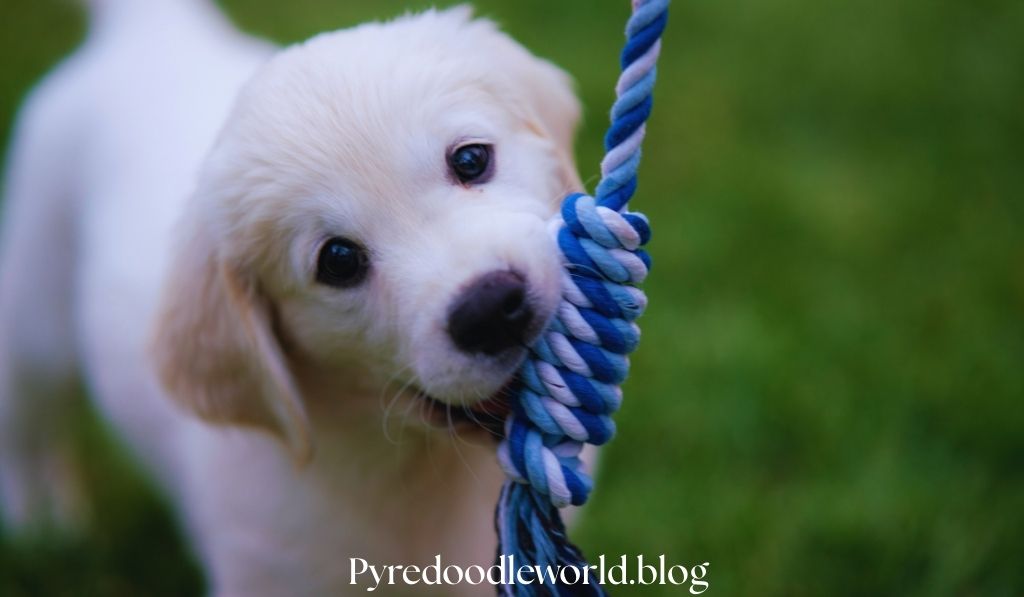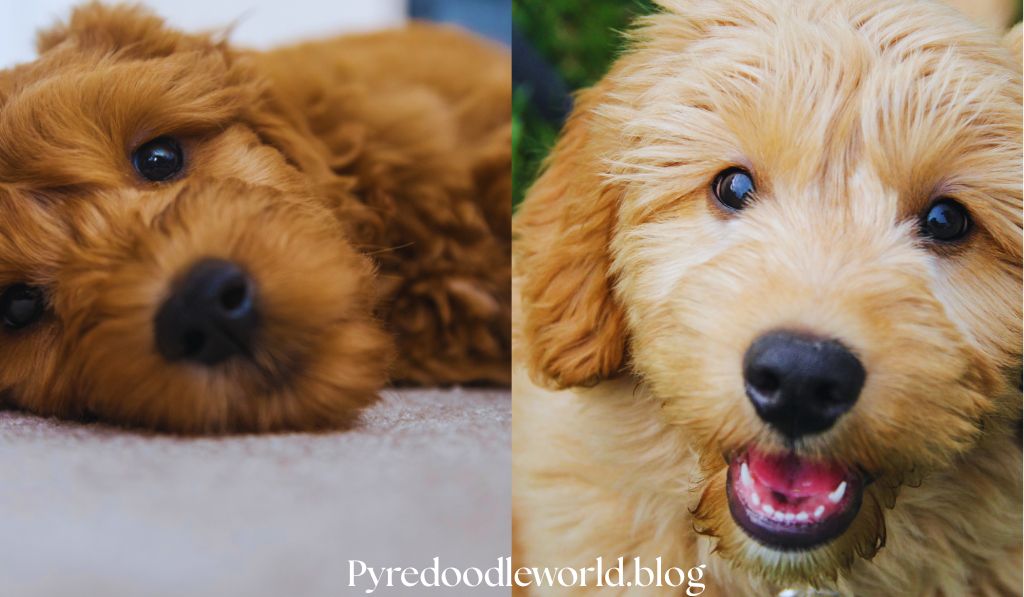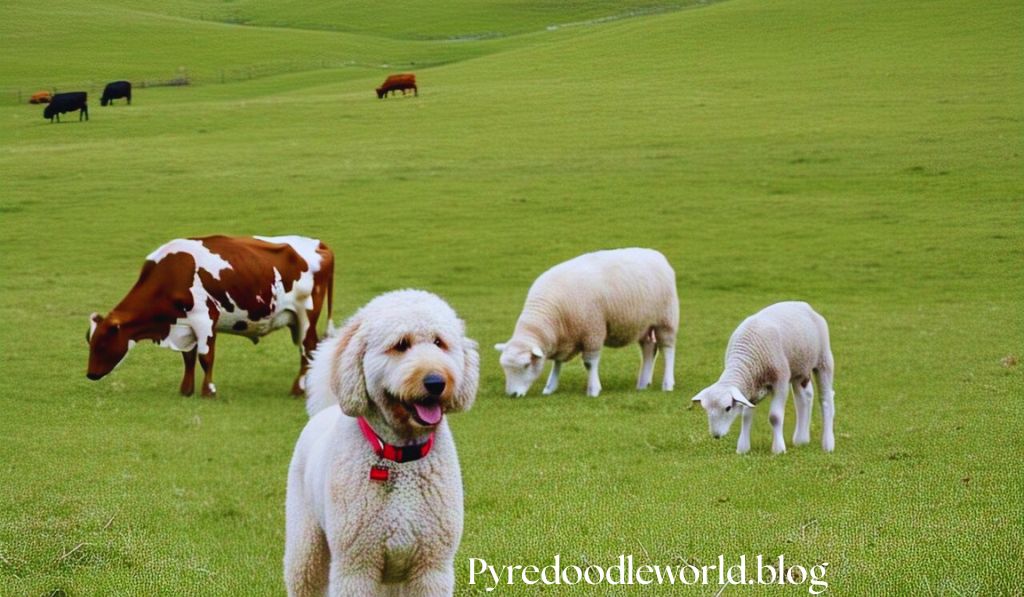As an experienced canine behaviorist, I can tell you that incorporating a Pyredoodle into your household is an excellent decision.
These magnificent crossbreeds, combining the Great Pyrenees and Standard Poodle lineages, offer an unparalleled blend of intelligence and affection that makes them exceptional family companions.
However, your success with these wonderful dogs hinges significantly on implementing proper training protocols and socialization techniques from day one.
Without these foundational elements, even the most genetically gifted Pyredoodle may develop behavioral challenges.
In this comprehensive training guide, you’ll discover professional strategies for Pyredoodle behavioral development, grooming requirements, and essential care practices that will transform your puppy into a well-adjusted and contented adult dog.
Understanding Your Pyredoodle

Breed Origins and Characteristics
The Pyredoodle represents a thoughtful crossbreeding effort combining two remarkable purebreds.
These substantial, intellectually gifted canines typically stand between 20-32 inches at the shoulder with weight ranges of 50-90 pounds, depending on genetic expression.
Their coat presentation varies considerably, often displaying a medium-length wavy texture that blends the Poodle’s distinctive curls with the luxurious double coat of the Great Pyrenees.
Their impressive stature combines with their gentle disposition to create a companion that excels in family environments.
Genetic Heritage
- Great Pyrenees Influence:
Your Pyredoodle inherits several key attributes from this mountain guardian breed, including protective instincts, territorial awareness, and remarkable loyalty.
Historically employed as livestock guardians in mountainous regions, Great Pyrenees contribute a calm vigilance and devoted temperament to the Pyredoodle genetic profile.
- Standard Poodle Contribution:
The Poodle genetics in your Pyredoodle provide exceptional cognitive capabilities and trainability.
Consistently ranked among the most intelligent canine breeds, Poodles bring problem-solving skills, learning aptitude, and adaptability to this hybrid. Their playful disposition and athletic abilities further enhance the Pyredoodle’s behavioral repertoire.
The intentional combination of these distinctive genetic lines produces a companion with balanced characteristics—intelligence paired with devotion, protective instincts tempered by sociability, and working-dog drive balanced with companionable qualities.
Behavioral Profile and Temperament
Inherent Sociability
Pyredoodles demonstrate remarkable affinity for human interaction. Their inherent sociability manifests as deep bonding with family members and genuine enjoyment of companionship.
This intrinsic social nature makes them particularly suitable for households with children, though proper introduction protocols remain essential for optimal integration.
Motivational Drives and Training Receptivity
You’ll find that Pyredoodles possess significant motivation to please their handlers, a characteristic that greatly facilitates training protocols.
This intrinsic desire for approval enables efficient skill acquisition when paired with appropriate positive reinforcement techniques.
Their handler-focused orientation makes them particularly receptive to consistency-based training approaches.
Activity Requirements and Stimulation Needs
Despite their gentle demeanor, Pyredoodles maintain substantial energy reserves requiring systematic outlets.
Their physical and mental stimulation requirements necessitate structured exercise routines and cognitive challenges. Without appropriate energy channeling, these intelligent dogs may redirect their capabilities toward undesirable behaviors.
Implementing daily activity protocols combining cardiovascular exercise with mental engagement represents an essential component of behavioral management.
Implementing Effective Training Protocols

Early Developmental Training
Training implementation during the critical developmental window (8-16 weeks) establishes optimal behavioral foundations.
During this neurologically receptive period, your Pyredoodle’s capacity for learning fundamental commands and household expectations reaches its peak efficiency.
Focus your early training sessions on establishing reliable responses to basic directives including “sit,” “stay,” “come,” and “leave it” as these form the communication framework for all future behavioral development.
Read also: Miniature Pyredoodle: Complete Owner’s Guide for 2025
Evidence-Based Training Methodologies
Positive Reinforcement Implementation
Utilizing science-backed positive reinforcement techniques yields superior results with Pyredoodles.
This approach leverages their natural motivation systems by pairing desired behaviors with immediate rewards—high-value treats, enthusiastic verbal affirmation, or interactive play sessions.
This methodology creates clear associations between specific actions and positive outcomes, establishing reliable behavioral patterns without compromising the human-canine bond.
Consistency Frameworks and Routine Establishment
Developing systematic training procedures with consistent cue delivery optimizes your Pyredoodle’s learning trajectory.
Maintain uniformity in command vocabulary and gestural signals across all household members to prevent confusion.
Structure training sessions in brief, high-engagement intervals of 5-10 minutes to maximize attention span utilization. Distributed practice (multiple short sessions) shows superior retention outcomes compared to massed practice (fewer longer sessions).
Addressing Training Complexities
While Pyredoodles demonstrate impressive learning capacities, you may encounter occasional resistance stemming from their Great Pyrenees heritage’s independent decision-making traits.
When confronting training plateaus, implement strategic adjustments rather than escalating correction intensity.
Analyze environmental factors, reassess motivational incentives, and consider potential physical discomfort before modifying your approach.
Patience combined with analytical problem-solving typically resolves training challenges without compromising trust.
Socialization Engineering
Developmental Socialization Significance
Systematic socialization represents a non-negotiable component of Pyredoodle development. Properly executed exposure protocols during critical developmental windows significantly reduce anxiety responses and fear-based behaviors.
A comprehensively socialized Pyredoodle demonstrates appropriate confidence in novel environments and relaxed interaction with unfamiliar humans and animals—essential qualities for a well-integrated family companion.
Strategic Socialization Activities
Implement a progressive socialization matrix including controlled exposure to diverse environments, individuals, and other animals.
Arrange supervised interactions at designated canine recreation areas where appropriate play behaviors can be reinforced. Enroll your Pyredoodle in structured socialization classes that provide monitored experiences with various stimuli.
These controlled environments allow you to shape appropriate responses while preventing negative associations.
Grooming Requirements and Care Protocols

Coat Maintenance Systems
Your Pyredoodle’s distinctive coat requires systematic maintenance to prevent matting complications and maintain optimal skin health.
Establish a regular brushing schedule with frequency determined by your individual dog’s coat expression—typically ranging from twice weekly to daily sessions during seasonal transitions.
Select appropriate grooming tools based on coat texture, often combining slicker brushes for surface maintenance with dematting tools for undercoat management.
Preventative Health Monitoring
Implement routine health surveillance practices including scheduled veterinary assessments to monitor developmental progression.
Pyredoodles demonstrate genetic predispositions for specific health considerations including hip joint abnormalities, gastric torsion vulnerability, and certain ophthalmic conditions.
Establishing baseline health parameters through regular professional evaluation allows early intervention for emerging concerns, significantly improving long-term outcomes and reducing treatment complexity.
Advanced Training Considerations
Environmental Adaptation Training
Beyond basic obedience, your Pyredoodle benefits from systematic desensitization to environmental variables they’ll encounter throughout their lifespan.
Implement graduated exposure protocols for potentially challenging stimuli including vehicular transportation, veterinary handling procedures, and household maintenance equipment.
This proactive approach prevents anxiety development and establishes adaptive behavioral patterns for novel situations.
Specialized Training Applications
Consider your Pyredoodle’s genetic heritage when exploring advanced training directions. Their intelligence and physical capabilities make them exceptional candidates for specialized training including:
- Therapy Work Preparation: Their intuitive empathy and gentle demeanor create excellent foundations for therapeutic applications.
- Scent Detection Activities: Poodle olfactory capabilities combined with work drive create aptitude for scent-based challenges.
- Agility and Coordination Development: Their athletic physique enables impressive performance in structured physical challenges.
These specialized applications not only enhance your Pyredoodle’s skill development but also provide essential mental stimulation that prevents behavioral issues resulting from cognitive underutilization.
Nutrition and Exercise Integration

Dietary Requirements for Optimal Development
Your Pyredoodle’s substantial size and energy requirements necessitate carefully calibrated nutritional support.
Select premium formulations specifically designed for large-breed development to regulate growth rates and support joint health during critical developmental stages.
Portion control remains essential throughout their lifespan to prevent obesity-related complications that could exacerbate orthopedic stress.
Exercise Protocol Engineering
Implement a comprehensive exercise regimen combining:
- Cardiovascular Conditioning: Structured walking or jogging sessions maintaining appropriate duration for developmental stage.
- Mental Stimulation Activities: Problem-solving challenges including puzzle feeders and scent-based games.
- Controlled Play Sessions: Interactive activities that reinforce appropriate play behaviors while providing exercise.
Your Pyredoodle requires 45-60 minutes of dedicated physical activity daily, ideally distributed across multiple sessions to prevent overexertion while satisfying their substantial energy requirements.
Addressing Common Behavioral Challenges
Separation Anxiety Management
Pyredoodles often form intensely strong attachments to their families, potentially predisposing them to separation-related distress.
Implement systematic desensitization to brief separations beginning in early development. Gradually increase duration while providing self-soothing tools including interactive toys and comfort items bearing familiar scents.
Create positive associations with departure cues through counterconditioning protocols to prevent anxiety escalation.
Property Guardian Behaviors
The Great Pyrenees lineage contributes territorial protection instincts requiring careful management. While natural alertness provides valuable household awareness, excessive territorial behaviors require early intervention.
Implement clear protocols distinguishing between appropriate alerting and problematic reactions. Reinforce calm acceptance of approved visitors through systematic exposure and reward-based training to prevent territorial escalation.
Adolescent Development Phase
Prepare for transitional challenges during the adolescent period (approximately 8-18 months) when hormonal changes may temporarily impact established training.
During this period, maintain consistent expectations while recognizing the biological influences affecting behavior.
Rather than interpreting regression as training failure, view this phase as an opportunity to reinforce foundational skills through patient repetition and continued positive reinforcement.
Frequently Asked Questions
What lifespan expectations should I have for my Pyredoodle?
With appropriate healthcare implementation and genetic factors, most Pyredoodles enjoy life spans of 10-14 years. Preventative healthcare protocols significantly influence longevity outcomes.
Do Pyredoodles truly offer hypoallergenic qualities?
While individual coat expressions vary, many Pyredoodles inherit Poodle coat characteristics that reduce allergen shedding.
However, no dog achieves complete hypoallergenic status, as allergic reactions stem from various proteins found in saliva and dander beyond coat considerations.
What daily exercise volume optimizes Pyredoodle behavioral health?
Your adult Pyredoodle requires 45-60 minutes of dedicated activity daily, with intensity calibrated to age and physical condition.
Exercise insufficiency commonly manifests as destructive behaviors, excessive vocalization, and attention-seeking activities.
What health surveillance priorities should I establish?
Implement routine monitoring focused on hip and joint function, cardiac assessment, thyroid function, and ophthalmological health. These systems represent common areas of concern based on parent breed predispositions.
How can I identify reputable breeding programs?
Select breeders demonstrating comprehensive health testing protocols, transparent medical history documentation, and willingness to provide parental temperament access.
Responsible breeders prioritize socialization beginnings and refuse early separation from littermates regardless of financial incentives.
Conclusion: Your Pyredoodle Partnership
Establishing an effective training foundation with your Pyredoodle creates a rewarding partnership built on mutual understanding and clear communication.
By leveraging their natural intelligence, social orientation, and desire to please, you’ll develop a companion that seamlessly integrates into your household dynamics.
The investment you make in early training, proper socialization, and consistent reinforcement pays dividends throughout your Pyredoodle’s lifetime.
Their unique combination of protective instincts, intellectual capabilities, and affectionate nature makes them exceptional companions when provided appropriate guidance and structure.
By implementing the professional techniques outlined in this guide, you’re establishing the framework for a harmonious relationship that showcases the remarkable capabilities of this magnificent hybrid breed.
Your well-trained Pyredoodle will demonstrate the perfect balance of gentle companionship and capable confidence that makes these dogs such treasured family members.



